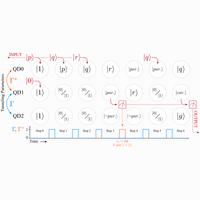Abstract
We present a proposal for a one-bit full adder to process classical information based on a few electrons in a triple quantum dot system, serving as a proof of principle for the development of energy-efficient information technologies operating through coherent quantum dynamics. The device works via the repeated execution of a Fredkin gate implemented through the dynamics of a single time-independent Hamiltonian. Our proposal uses realistic parameter values and could be implemented on currently available quantum dot architectures. We compare the estimated energetic costs for operating our full adder with those of well-known fully classical devices, and we identify a few important factors for the future success of this technology.
- Received 7 August 2022
- Revised 28 May 2023
- Accepted 31 May 2023
DOI:https://doi.org/10.1103/PRXEnergy.2.033002
Published by the American Physical Society under the terms of the Creative Commons Attribution 4.0 International license. Further distribution of this work must maintain attribution to the author(s) and the published article's title, journal citation, and DOI.
Published by the American Physical Society
Physics Subject Headings (PhySH)
Popular Summary
At the heart of the modern computer is the CMOS transistor. With transistor manufacturing techniques now in the nanometer range, these devices are reaching their miniaturization limits. At these scales, unwanted quantum effects are a concern, and thermodynamic restrictions due to single-device dissipation severely limit device density. As an alternative computing technology, here the authors propose that logic devices whose operation relies on quantum dynamics, similarly to quantum gates being developed for quantum computation, may be used as energy-efficient building blocks for classical computation. Such a computer would not require the same level of isolation from the environment as a quantum computer, as coherence would be needed only at the level of each individual gate. This approach may facilitate the development of a scalable architecture, while still taking advantage of the efforts being put into the development of a quantum computer. In this proposal the authors study a proof-of-principle universal gate using semiconductor quantum dots, which could benefit from the already advanced semiconductor fabrication techniques behind modern electronics. The authors compare the energy use of the proposed gate with that of modern computers and highlight the challenges that remain to achieve energy-efficient classical computation exploiting quantum dynamics.


